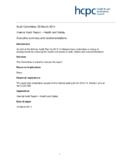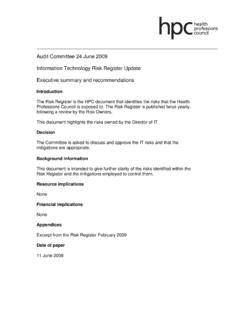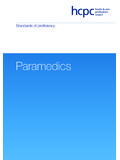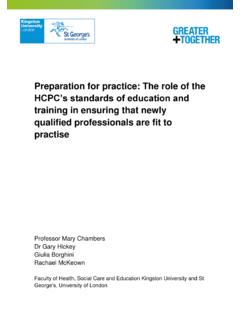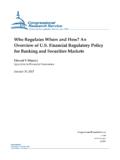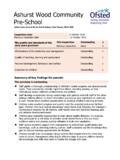Transcription of Service User Feedback Tools - HCPC
1 Service user Feedback Tools AN EVIDENCE REVIEW A N D D E L P H I CONSULTATION FOR THE HEALTH PR OFE SS I ON S COU N CI L DR ALISON CHISHOLM & HELEN SHELDON P I C K E R I N S T I T U T E E U RO P E NOVEMBER 2011 Picker Institute Europe Picker Institute Europe is a not-for-profit organisation that makes patients views count in healthcare. We: build and use evidence to champion the best possible patient-centred care w o r k w ith patients, professionals and policy makers to strive continuously for the highest st andards of pat ient experience. Picker Institute Europe 2011 Published by and available from: Picker Institute Europe B uxt on Co urt 3 W e st W a y Oxford OX2 0JB Tel: 01865 208100 Fax: 01865 208101 in fo @ pi ck e re ur o pe.
2 A c .uk Registered charity no 1081688 Company limited by registered guarantee no 3908160 CONTENTS Executive summary 1 1 Literature review: approach 5 Policy context 5 Registrant characteristics 6 Service user characteristics 6 Service user assessment of non-technical skills 7 Service user capacity to assess technical competence 8 Research questions 9 Review methodology 9 2 Literature review: findings 12 Instruments in use 12 Areas of professional practice covered 18 Implementation 18 Reliability and validity 20 Qualitative approaches to gathering Feedback 24 Evidence for feasibility and effectiveness 25 3 Delphi consultation 33 Approach 33 Delphi findings 34 Delphi Round 1.
3 Incorporating Service user Feedback 34 Delphi Round 2: responses to statements 35 Delphi Round 3: achieving consensus 43 4 Conclusions and recommendations 47 Literature review 47 Formative and/or summative use 47 Design of instruments 48 Feasibility 49 Effectiveness 49 Delphi consultation 50 Appendix 1: literature review references 52 Appendix 2: literature review search terms 56 Appendix 3: literature review databases 57 Appendix 4: professional bodies and associations contacted 59 Appendix 5: four methodologies used by Davies et al (2009) 61 Appendix 6: Delphi Round 1 questions 63 Appendix 7: Delphi Round 2 evidence review question 64 Appendix 8: Delphi Round 2 questionnaire 65 Appendix 9: Delphi Round 2 responses 71 Appendix 10: verbatim responses to the 28 Round 2 Delphi statements 87 Appendix 11: Delphi consultation Round 3 questionnaire 108 Appendix 12: responses to the 10 Delphi Round 3 statements 111 P2453 Health Professions Council/ Service user Feedback Tools /DS/AC/HS 1 Executive summary Background and aims On-going assessment is essential for health practitioners life-long learning and the quality of the care they provide, as well as to demonstrate on-going professional competence in interpersonal and ethical spheres of practice to a public increasingly interested in evidence of professionalism.
4 The case for the principle of obtaining Service user Feedback on health professionals practice i s st ro n g, particularly for those professional groups who have direct contact with lay Service users. S e r v i c e-users are uniquely placed to assess many aspects of the practitioner-s e r v i c e-us e r interaction which have been demonstrated to be associated with satisfaction, engagement and clinical outcomes. The HPC s registrants work within a wide range of settings and with a great diversity of Service users. Th e H PC d o e s n ot c ur r e nt l y ma n d at e t h e us e o f s e r vi c e user Feedback as evidence of their pr o f e s si o n a l i s m o r o f t h e i mpa ct o f C PD o n t h e i r practice.
5 This research a i ms t o examine available evidence regarding the use and impact of Service user Feedback Tools in healthcare, and explore the views of people within the professional bodies of those professions regulated by the HPC on the use of Service user Feedback wi t h a vi e w t o i n fo rmi n g de ci s i o n s a bo ut its introduction to the practice, appraisal, CPD, regulation and/or revalidation of the HPC s registrants. Methods and approach Two methods were employed: 1. A review of peer-reviewed and grey literature was carried out to identify instruments and systems developed to gather Service user Feedback for the professional groups regulated by the HPC. Professional associations were also approached for information they held about Feedback instruments.
6 The review identified existing Tools , how they are used and evidence for their robustness and effectiveness. It covered standardised questionnaire instruments as well as more qualitative approaches, and paid special att ention t o seldom heard groups. It also drew on the more established literature on patient Feedback instruments used to assess doctors, drawing lessons from this field where the state of the science is arguably more advanced. 2. A D e l ph i Co n s ul t at i o n wa s c a r r i e d o ut t o i de n t i f y a r e a s o f co n se n s us o n t h e us e of Service user Feedback between individuals from organisations representing the professions governed by the HPC. They were asked about their hopes and concerns relating to the possibility of the HPC incorporating Service user Feedback in its regulatory processes.
7 N e x t , p a rticipants were asked to indicate their level of agreement with, and to comment on, statements developed from these responses combined with the findings of the literature review. Finally, ten statements that appeared likely to generate consensus were developed from the P2453 Health Professions Council/ Service user Feedback Tools /DS/AC/HS 2 analysis of responses and again, participants were asked to indicate their level of agreement with, and comment on, each statement. Summary of findings The search found twelve standardised instruments covering ten professional groups and a range of areas of professional practice including communication, respect for privacy, role in providing training, body language, competence in developing therapeutic relationship.
8 Absolute consistency in methods of administration is difficult to achieve, and is known to have an impact on the comparability of scores. Further evidence for validity and reliability of most of the standardized instruments is needed, but this work is underway and should be built on. Evidence from patient Feedback inst rument s for doctors has highlighted the potential effects of confounding factors and the possibility for unfair discrimination. Qualitative approaches do not allow comparisons between individuals or over time, and make it difficult to preserve anonymity. However, t h e y h a ve t he advantages of enabling Service users who are not able to complete standardized questionnaires to have a voice, and to obtain more nuanced, context-based Feedback .
9 Some h a v e been developed for other purposes ( Service evaluation, consultation) and could potentially be adapted to obtain Feedback on individual practitioners. Conclusions and recommendations 1. The HPC s registrants work within a wide range of settings and with a great d i ve r si t y o f se r vi c e us e r s . S o me h a ve t h e o p po rt un i t y t o forge ongoing relationships with their Service users, whereas others see them only fleetingly if, indeed, at all. The Service users with whom HPC s registrants work vary in their levels of abilities and disabilities. G i ve n t h e wi d e r an g e o f set t i n g s i n which, and Service users with whom, HPC registrants practice, approaches to obtaining Service user Feedback must be: tailored to the professional group and, in cases where there is variation in settings, Service user groups etc, even to subsets of one professional g ro up ; designed according to judgments about the capacity and willingness of a particular Service user group to respond to a particular form of assessment: a standard format questionnaire, story-telling, supported conversation, or a face-to-face evaluation, bearing in mind the costs and b e n e f it s o f e a ch.
10 Where possible, Service users should be given a choice of how they would like to participate i n fe e db a ck . 2. Existing instruments should be built on, and any work to develop systems for Service user Feedback should consider work being carried out in Scotland to test the validity and reliability of the CARE instrument for assessment of relational empathy in 8 professional groups. P2453 Health Professions Council/ Service user Feedback Tools /DS/AC/HS 3 3. No evidence was found for the capacity of the standardised instruments or qualitative methods reviewed here to contribute to the improved professional practice of those on whom Feedback was gathered.
